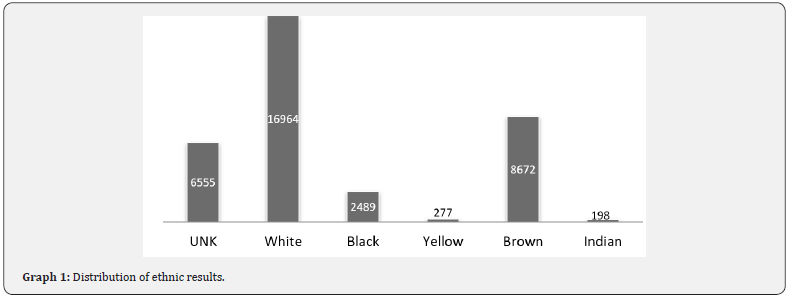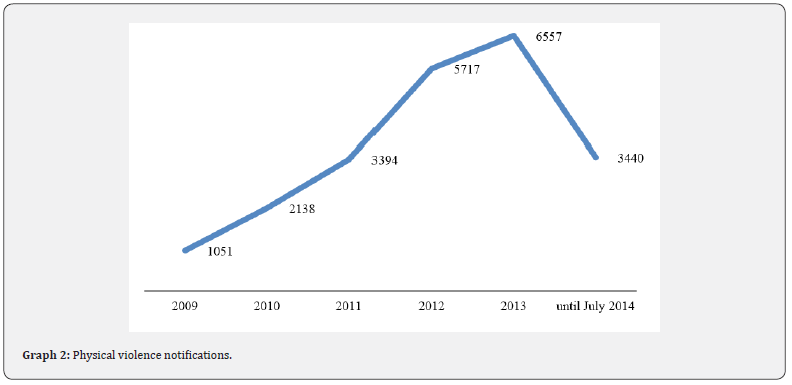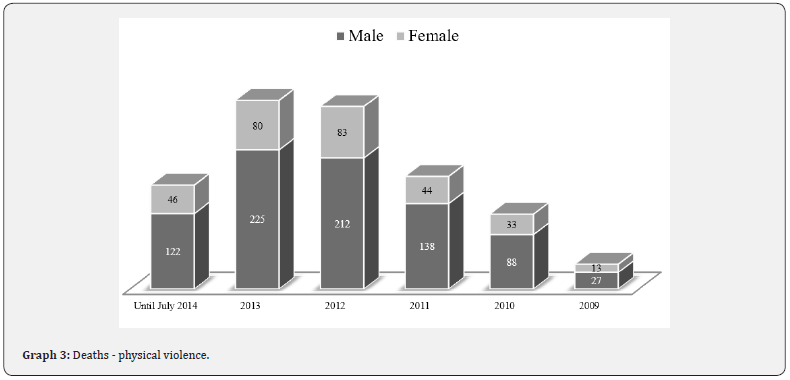Forensic Sciences & Criminal Investigation - Juniper Publishers
Abstract
Context and Objective: The occurrence of suspected cases of abuse against older adults is a global phenomenon; health professionals must pay close attention to the possibility of abuse against this population. This study aimed to describe the profile of notifications of abuse against older adults reported in SINAN (the official database of the Brazilian Ministry of Health) between 2009 and July 2014.
Design: Cross-sectional study.
Setting: The manuscript was produced in the Department of Legal Medicine of the Medical School of Universidade de São Paulo and ABC Faculty of Medicine.
Methods: Data on domestic, sexual, and other forms of violence were obtained from the Ministry of Health’s official website (Sistema de Informação e Agravos de Notification – SINAN) between 2009 and July 2014 (http://dtr2004.saude.gov.br/ sinanweb/index.php). The selected subjects were elderly aged 60 years or older of both sexes.
Results: The number of notifications showed a proportional increase between 2009 and mid-July 2014; most of the attacks occurred in the victims’ homes, and the most frequent aggressors were sons or daughters, followed by unknown people and acquaintances. Women were the most attacked. Many aggressions were recurrent and in multiple forms, but physical aggression and negligence were the most reported.
Conclusion: This study’s great importance is exposing the quantitative data of this violent scenario so that health professionals who care for older adults remain alert to the possibilities of mistreatment and that they notify suspected or proven cases, as determined by Brazilian law.
Keywords: Older adults; Abuse; Neglect; Physical signs; Incidence; Violence
Introduction
With the global growth of the elderly population, specific issues related to this group of individuals should be widely discussed. Among these issues is violence, which is essential because mistreatment of older people is associated with distress and increased mortality [1]. Therefore, it is a serious public health problem.
Abuse is defined as violating an individual’s human and civil rights. The abuse might consist of a single or repeated act, often affecting vulnerable people and occurring in any relationship. The following six types of abuse have been described: physical, sexual, psychological, financial, or material, neglect or act of omission, and discriminatory [2]. According to the Brazilian Institute of Geography and Statistics (IBGE) [3], in 1950, older adults comprised 4% of the country’s total population; in 1991, they represented 7.3%; 8.6% in 2000 (14.5 million) [4]; and 10% in 2010. Thus, according to the World Health Organization (WHO), Brazil is experiencing a rapid increase in the number and percentage of older people, often within a single generation, and needs to adjust to this new reality [5]. Brazilian laws are strict regarding the notification of confirmed or suspected cases of abuse against older people. Law nº. 12.461 (2011), amended Article 19 of the Statute of the Elderly (Law nº. 10.741/2003), is more rigorous than the previous law. It mandates that the notification of abuse against older adults be compulsory, even in suspected cases, and should be performed by health authorities through private and public health services and any official agency (Police authority; Public Ministry; Municipal Council for the Elderly, the State Council of the Elderly, and the National Council for the Elderly) [5,6].
Concerning the sub notification, Cooper et al. [1] in a systematic review published in 2008, concluded that 6% of older people reported significant abuse in the last month, 5.6% of couples reported physical violence in their relationship in the last year, and one in four vulnerable elders are at risk of abuse; however, only a tiny proportion of this abuse is currently detected. In Brazil, according to the Information System of Aggravation of Notification (SINAN Net), which is associated with the Brazilian Ministry of Health, there were significant fluctuations in the total numbers of specific notifications of abuse and violence-related deaths among people over age 60 between 2009 and 2011 [7]. In 2009, there were 1748 notifications of abuse, 2.5% of which resulted in death; 3298 notifications of abuse, with 1.17% of these resulting in death, occurred in 2010, and 5307 notifications of abuse, with 4.6% of these cases resulting in death, occurred in 2011 [6,7]. Mascarenhas et al. [7] evaluated many aspects of the reports of violence against older adults in the Brazilian Health Services [7,8]. These authors described the victims’ profile as Caucasian males, between 60 and 69 years of age, single or widowed, with low education levels, and with no physical disabilities or mental or behavioral disorders. Physical violence was prevalent among men, whereas psychological violence, sexual violence, and neglect were more prevalent among older women [7,8]. Another Brazilian study showed that women over 75 years of age, single or widowed, with low education levels and chronic diseases, are primary abuse victims [8,9]. This data will facilitate the assessment of the primary at-risk groups suffering from violence and provide information for establishing public policies to reduce the number of abused elderly individuals. Thus, medical physicians and forensic examiners should recognize these signs to identify cases of abuse against older adults and avoid recurrences in non-fatal violence and vengeful perpetrators.
Objectives
This study aimed to describe the profile of notifications of abuse against older adults reported in SINAN (the official database of the Health Ministry of Brazil) from 2009 to July 2014.
Methods
The results of this cross-sectional study were conducted through analysis of data published on the official website of the Brazilian Ministry of Health: SINAN Net. (http://dtr2004.saude. gov.br/sinanweb/). The information in this database included notifications of violence (domestic, sexual, and other types of violence against the older adults), which were included in the list of compulsory notifications of violence according to the Ordinance GM/MS Nº 104, January 25, 2011. We analyzed the notifications from 2009 to July 2014. The study parameters included the sex and age of the victim, the victim’s relationship to the perpetrator, the place of the aggression, and the type and form of the aggression. The results were compared with data from the literature.
Results
Total numbers
In the period from January 2009 to July 2014, the SINAN (official database of the Brazilian Ministry of Health) received 655,720 compulsory notifications of violence, and 35,155 of these cases involved the older adults population (over 60 years of age), representing 5.36% of the total.

Setting of the aggression, sex, and ethnicity of the victims
68% of these cases (24,167) occurred in the victim’s residence, and were reported 12,314 cases recurrent violence, which resulted in 1111 deaths. The women were the most frequent victims, accounting for 54% of total aggressions (maintaining the ratio above 50% for all study years), ethnicity was Caucasian (Graph 1), and 33,3% had low levels of education.
In the analyzed period, the average percentage of elderly victims of total violence remained stable, at around 5.14%, compared to the total violent notifications (all ages), as shown in Table 1.

The physical violence and deaths
However, from 2009 to July 2014, notification of physical violence against older people increases in Brazil (Graph 2). The partial number of notifications until July exceeded the total number in 2011. In 2010 there was an increase of 103% compared to the previous year; in 2011, the increase compared to 2010 was 58,7%, and 68,44% in 2011 compared to 2012. However, there was a slowdown in 2013 when the increase in notification was 14,69% concerning 2012. The total of notifications of physical abuse was 23,542 in the period (2009 to July 2014), with 1111 deaths (Graph 3); 14,000 cases were caused by beating.

Physical abuse was more frequent in men (51,5%) than women, but the difference was irrelevant. The perpetrators were sons or daughters in 4,305 notifications. A stranger was the aggressor in 3,304 cases; friends were 2,696, and husband or ex-husband, the number of notifications, was 2,478. In the 2,558 aggressions, the instrument used was the knife.
Neglect, abandonment, and sexual violence
Neglect and abandonment were the second most frequent kind of violence against older people. In the period of this study, 9,296 notifications were performed, with 129 deaths. Women were the preferred victims, 4,872 cases (52,4%). Table 2 shows the notifications according to race. There were 9,241 cases of sexual and psychomoral violence reported during the period, of which 6,595 were women (71.36%). Considering only reports of isolated sexual violence, there were 782 cases, 94.91% of which involved women.
Discussion
Our study showed that 5.36% of the total notifications from January 2009 to July 2014 were related to older people.
A Portuguese study applied between January and June 2013 demonstrated that 23.5% of older adults have suffered some abuse, emotional and neglect especially; these results were obtained through a questionnaire [10], which may have facilitated the complaint. In Brazil, in 2013, notifications of violence against the older population were 5.7%. According to the WHO, 36% of American nursing home staff reported witnessing abuse in the past year, with 10% witnessing physical abuse and 40% witnessing psychological abuse.9,10 These data do not show the true scope of this type of crime, as most abusers are close relatives (i.e., sons and daughters). Another study (a systematic review of the prevalence of abused elderly individuals) showed that the prevalence of abused elderly individuals varies according to culture and the definition and measure of violence. According to these authors, 25% of older adults are at risk of abuse, although few cases have been identified1. Many forms of violence are imposed against older people, as these victims are vulnerable individuals who are often unable to react to attacks or depend on the abuser. In some situations, an old individual has difficulty understanding the violent act or does not want to report the abuser due to their relationship. The term “abuse against the elderly” has often been associated with physical aggression; however, neglect and emotional abuse (psychological) play essential roles [9,11]. Few studies consider neglect as a separate form of abuse. The definition of abuse against the elderly is complex, involves multiples phenomena, and varies considerably among researchers and between the laws of different countries, even among the states of a country, as in the U.S. Concerning determining the age limit of elderly individuals, some studies suggest ages above 60 years. In contrast, others only consider ages over 65 years. This varying definition is a problem that affects epidemiological studies of the incidence of these events. According to Akaza et al. (2010), other confounding factors involve the different classifications of the types of maltreatment (violence). For some authors, violence is classified into four types (physical, emotional, financial, and neglect). In contrast, others add self-neglect, sexual abuse, and other miscellaneous forms of abuse [11,12]. The prevalence of elderly abuse is difficult to determine, as some studies define older adults as over 60. In contrast, other studies consider people over 65 years. Although all people can be battered, the most frequent victims are vulnerable individuals, such as children, teenagers, women, homosexuals, people with disabilities or mental disorders, and the elderly [8,11]. The Ministry of Health warns that falling accidents among the elderly and their consequences have become an epidemic in Brazil, with more than 20,000 hospitalizations in 2009. The Brazilian government recommends that all physicians who evaluate elderly individuals suffering from falls (accidental or not) ask these individuals whether there were any other injuries or falls in the last six months [12,13].


In 2007, according to the Ministry of Health, 18,946 older adults died from external causes, representing the seventh leading cause of death, and 125,000 hospitalizations were recorded that same year. In 2010, the WHO reported that 41 elderly individuals die each day worldwide from external causes, representing this group’s sixth leading cause of death, emphasizing that these events remain incredibly underreported [13,14]. In our study, relatives, mainly daughters, and sons, were the significant perpetrators of abuse against older people, and the aggression occurred inside the home. These data were similar to those observed in medical literature. Alcoholism among the offenders was a factor in many reports. Other similarities between the Brazilian results and the descriptions in the literature showed that women were the principal victims. The differences between the gender data obtained in SINAN were mild, although women were the most victimized every year [7,14]. These results were similar to those of Souza et al. [15], perhaps reflecting the greater longevity of women [15].
Although abuse against the elderly is not recent, only from the late 1980s, it has become a topic of interest. Indeed, the notifications recorded in the databases do not represent the actual number of deaths or injuries suffered within this population. Under notification might partially reflect that the clinical manifestations of abuse are often mistaken for the manifestations of diseases inherent to aging [15,16] (e.g, bruises). Some studies show that the presence of bruises greater than five centimeters in size on the lateral arm or right shoulder, neck, head, thoracolumbar region, buttocks, and soles of the feet are not often observed in accidental injuries and should be considered to result from an act of violence [17].
Multiple wounds in different stages of cicatrization; bruises at different stages of evolution (purple, brown, green, yellow, and finally brownish yellow); injuries in the shape of any instrument, marks of containment on the wrists, ankles, and heels; traumatic alopecia, edema of the scalp, and fractured teeth or nose or burns are other warning signs. Radiological images showed that misaligned fractures in different stages of consolidation could also be signs of physical aggression [17-21]. On the other hand, pressure sores, localized areas of tissue damage, or necrosis are common in the older population. However, Santos et al. [20] state simple care can prevent pressure sores. Therefore, the presence of these lesions might be an indicator of inadequate care. Is important to point out that, as Mosqueda et al. [22] say, “innocent bruises frequently occur on the extremities”. Although recognizing this abuse is difficult due to physiological aging, it should always be considered, particularly when the clinical history contradicts the findings of physical or laboratory examinations.
Another explanation for the low rate of notification of abuse against the elderly is that health professionals are not attentive to this possibility and that older people frequently are silent victims. The violence perpetrated through negligence principally occurs in a domestic environment and frequently involves the family, which makes diagnosis difficult. In many instances, the victim does not report the violence because they do not understand the incident as a form of violence or are afraid to report their close relatives as the perpetrators. According to Minayo [13], deaths, injuries, and trauma from traffic accidents and falls could also suggest negligent acts committed by the authorities or people involved with the accessibility of the elderly individual. Finally, we have to remember that signs suggestive of sexual violence injuries are also frequent, and include itching, anal or vaginal bleeding and pain, sexually transmitted diseases, and spotting or bleeding in the underwear21. Physicians, including coroners, should pay attention to elderly individuals with these lesions during their examinations, as there are many types of abuse against the elderly, and the diagnosis is difficult.
Final Considerations
The importance of our study is to show the large number of cases of violence that occur in our country, totaling 23,542 cases in the period studied, with an unspeakable tragedy represented by the 1,111 deaths that occurred in this period. Notably, our study also showed that assistance from health professionals facilitates the identification and confirmation of cases of maltreatment against the elderly and reporting, which is required by Brazilian law. Worrisome, this study showed that the number of abuse notifications against the elderly has grown in Brazil. Men and women are victims of physical, sexual, and neglect abuse, often recurrent and fatal. With the increasing life expectancy of the world population, issues involving older individuals are becoming common in medical practice. Among these issues, violence against older adults must be analyzed carefully, as many forms of violence leave no visible marks (neglect, psychological and economic violence), and many injuries to the elderly result from advanced age (fractures from falls and bruises). The information provided to physicians does not always represent the truth. Thus, physicians need to be alert to the possibility of violence against older adults, as the recurrence of maltreatment, and to report suspected or confirmed cases.
To Know more about Journal of Forensic Sciences & Criminal Investigation
Click here: https://juniperpublishers.com/jfsci/index.php
To Know more about our Juniper Publishers
Click here: https://juniperpublishers.com/index.php





No comments:
Post a Comment